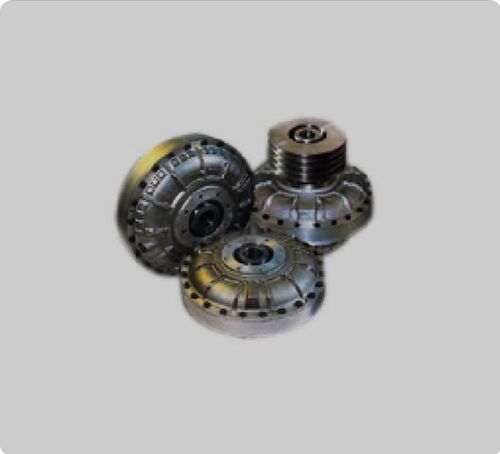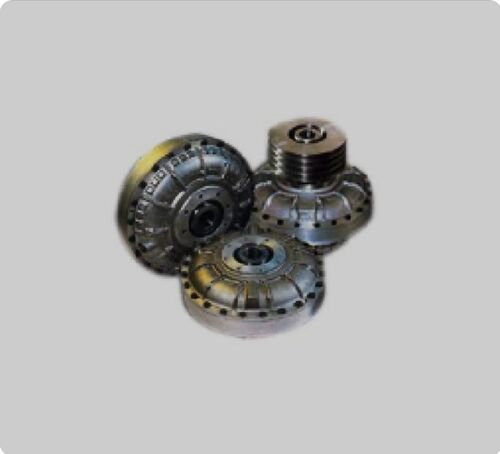
Fluid Coupling
10000 आईएनआर/Number
उत्पाद विवरण:
- उपयोग Automotive
- मटेरियल
- प्रॉडक्ट टाइप Fluid Coupling
- रंग Gray
- एप्लीकेशन Industrial
- सतह का उपचार
- Click to view more
X
फ्लुइड कपलिंग मूल्य और मात्रा
- नंबर
- 1
- नंबर
फ्लुइड कपलिंग उत्पाद की विशेषताएं
- Fluid Coupling
- Automotive
- Industrial
- Gray
फ्लुइड कपलिंग व्यापार सूचना
- Vadodara
- , ,
- प्रति महीने
- दिन
उत्पाद विवरण
Fluid couplings are mechanical devices used in various industrial applications to transmit rotational power from one shaft to another. They contain several key components designed to facilitate the transfer of torque while accommodating variations in speed and alignment between the input and output shafts. Here are the main components typically found in a fluid coupling:
- Impeller (Pump): The impeller is connected to the input shaft and is responsible for pumping the fluid (usually oil or a similar substance) inside the coupling. It imparts rotational kinetic energy to the fluid.
- Runner (Turbine): The runner is connected to the output shaft and is designed to receive the energy transmitted by the fluid from the impeller. As the fluid flows from the impeller to the runner, it causes the runner to rotate, thereby transmitting torque to the output shaft.
- Fluid: The fluid medium inside the coupling (often oil) transmits torque from the impeller to the runner. The properties of the fluid, such as viscosity and volume, affect the performance characteristics of the coupling.
- Shell: The shell encloses the impeller, runner, and fluid, providing a sealed environment. It also directs the flow of fluid from the impeller to the runner.
- Bearings and Seals: Bearings support the shafts and reduce friction, while seals prevent fluid leakage and maintain the integrity of the coupling.
- Fill and Drain Plugs: These are used for filling the fluid coupling with the appropriate fluid and for draining or replacing the fluid as needed for maintenance purposes.
Superior Surface Treatment
The fluid coupling is meticulously polished, resulting in a smooth and refined surface. This specialized treatment not only improves aesthetic appeal but also significantly bolsters resistance against abrasion and corrosion. Users can expect prolonged operational integrity, even in high-load industrial settings, making it an excellent choice for automotive solutions in India.
Reliable Industrial Application
Manufactured from high-grade stainless steel, this coupling delivers consistent torque and reliable power transfer in automotive machinery. Its robust construction and advanced surface treatment make it suitable for high-stress environments, reducing maintenance frequency and downtime. The gray finish enhances product identification and complements industrial design aesthetics.
FAQs of Fluid Coupling:
Q: How is surface polishing beneficial for the fluid coupling in automotive applications?
A: Surface polishing provides the fluid coupling with increased resistance to wear and corrosion, ensuring smoother operation and extending product lifespan in demanding automotive settings.Q: What material is used for this fluid coupling and why is it ideal for industrial use?
A: This fluid coupling is crafted from stainless steel, which offers exceptional strength, durability, and resistance to environmental factors, making it highly suitable for industrial automotive applications.Q: When should a polished fluid coupling be installed in an automotive system?
A: A polished fluid coupling should be installed whenever reliable power transmission and reduced vibration are necessary, especially in environments requiring high durability and minimal maintenance.Q: Where is this fluid coupling available for purchase or trade?
A: This fluid coupling is supplied and traded across India through reputable suppliers and traders specializing in industrial automotive components.Q: What is the process involved in achieving the polished surface finish on the fluid coupling?
A: The process involves mechanically polishing the stainless steel surface to remove imperfections, resulting in a smooth, gray finish that enhances the parts durability and visual appeal.Q: How is this fluid coupling typically used in industrial automotive settings?
A: It is used to connect drive shafts and transmit torque efficiently, reducing shock loads and ensuring smoother performance in automotive machinery and industrial systems.Q: What are the main benefits of selecting a fluid coupling with polished stainless steel for automotive applications?
A: Choosing this product ensures superior resistance to wear, reduced maintenance needs, and enhanced aesthetic appeal, all of which contribute to reliable and efficient operation in industrial automotive use cases.Tell us about your requirement

Price: Â
Quantity
Select Unit
- 50
- 100
- 200
- 250
- 500
- 1000+
Additional detail
मोबाइल number
Email
द्रव युग्मन अन्य उत्पाद
“हम गुजरात में ही काम कर रहे हैं।
”



